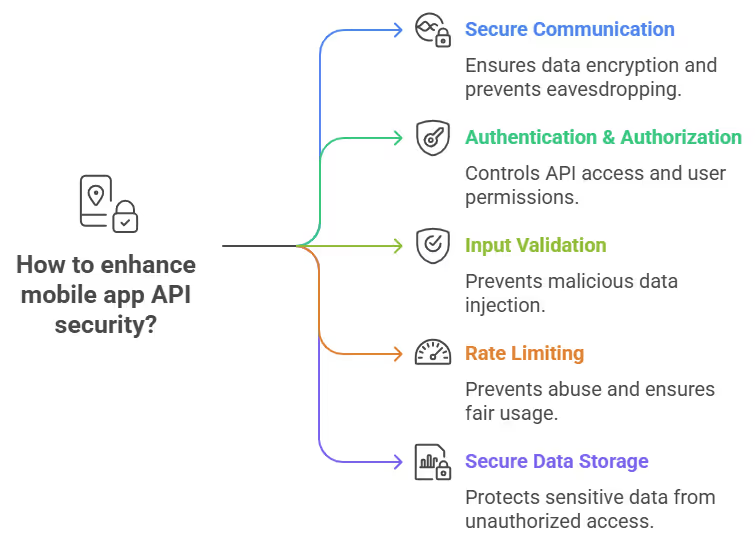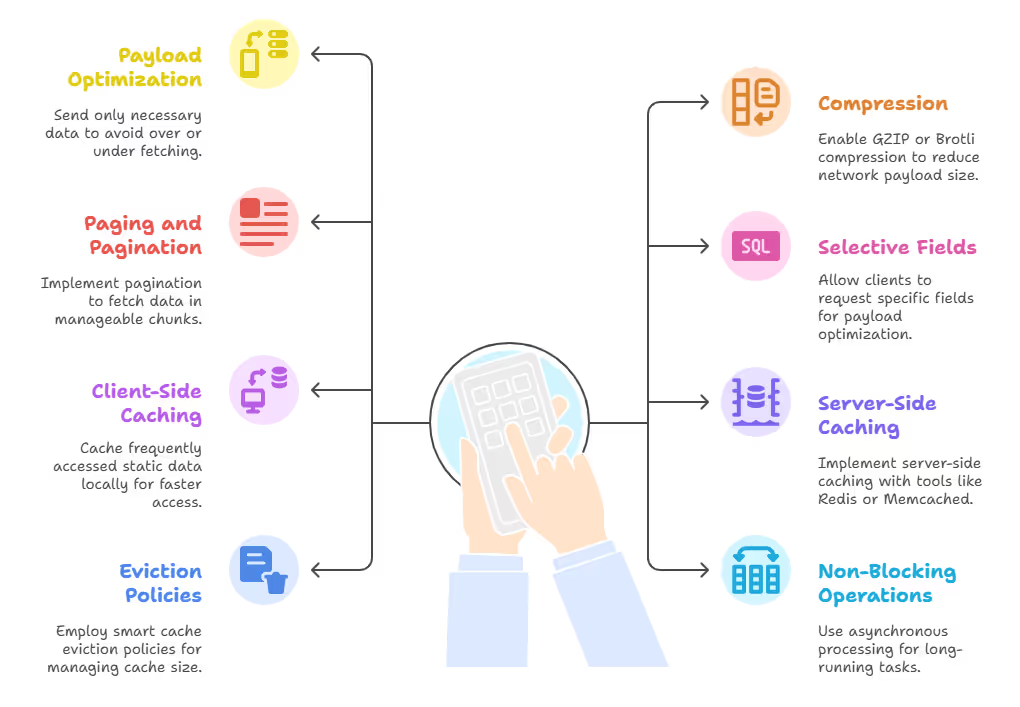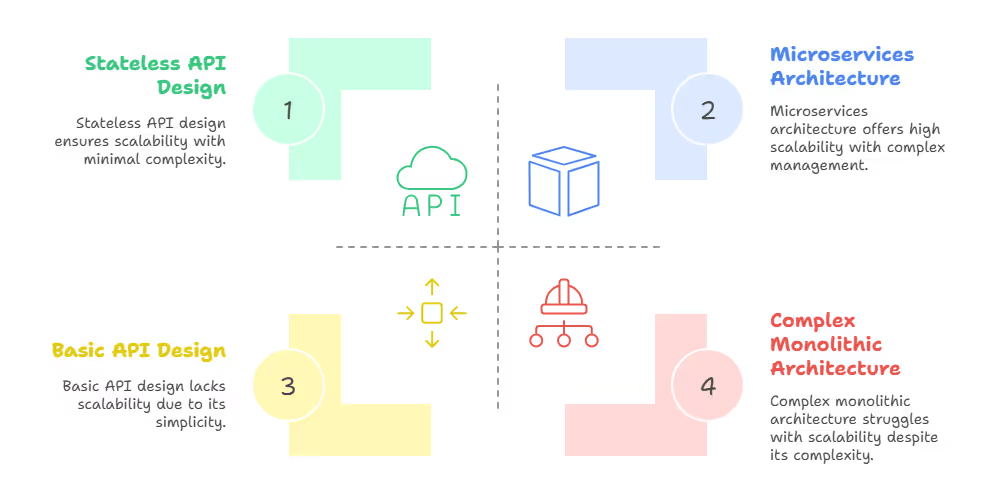Mobile App API Best Practices

APIs are the backbone of modern mobile apps, connecting front-end interfaces with backend services. For U.S. developers and product teams, mastering Mobile App API Best Practices is essential to building apps that scale without compromising on speed, security, or reliability. In this guide, we’ll explore proven API strategies that leading development teams use to deliver seamless mobile experiences.
Mobile App API Best Practices include designing APIs with a RESTful or GraphQL architecture, enforcing strong authentication, using version control, minimizing payloads, enabling caching, documenting endpoints clearly, and continuously monitoring performance.
Following these practices helps developers in the USA build mobile apps that are secure, scalable, and optimized for user experience.
Table of Contents
- Core Principles for API for Mobile Application Design
- Fortifying Your App: Mobile App API Security Practices I Swear By
- Boosting Performance for a Seamless User Journey
- Scaling for What's Next: Building a Resilient API for Mobile Application Development
- Evolving Your Mobile API Integration: Versioning and Deprecation, My Way
- Staying Ahead: Proactive Monitoring and Analytics for Mobile App API Health
- A Quick Look at API for Mobile Apps Authentication Methods
Mobile App API Best Practices include designing APIs with a RESTful or GraphQL architecture, enforcing strong authentication, using version control, minimizing payloads, enabling caching, documenting endpoints clearly, and continuously monitoring performance.
Following these practices helps developers in the USA build mobile apps that are secure, scalable, and optimized for user experience.
Principles for API for Mobile Application Design
I've learned that effective API for mobile application design isn't about haphazardly throwing functions together; it’s about architecting an interface that feels intuitive, operates efficiently, and gracefully accommodates future growth.
For those of you making the big decisions, this directly translates into leaner development cycles, quicker market launches for innovative features, and, crucially, a more stable product in the long run.
Why Consistency and Predictability Matter for Your Mobile App API
A consistent mobile app API design means that your developers can, almost instinctively, understand how to interact with various parts of your system without constantly hitting the documentation.
Trust me, this speeds up development cycles dramatically when you're integrating apis in mobile apps.
- Standardized Naming Conventions: I've always pushed for clear, logical, and consistent naming for endpoints, parameters, and responses. For example, if you use
/usersfor a list of users, then it logically follows that/users/{id}retrieves a specific user. Avoid quirky variations like/getAllUsersor/fetchUserData– consistency is king. - Uniform Error Handling: One of my early headaches involved APIs with wildly inconsistent error messages. Now, I always champion defining a crystal-clear, consistent structure for API error responses across every endpoint. This allows mobile apps to handle problems gracefully and give users meaningful feedback. A common pattern I've seen work well includes an error code, a human-readable message, and optional detailed diagnostics.
- Predictable Data Formats: My go-to for requests and responses is overwhelmingly JSON (JavaScript Object Notation). It's lightweight, incredibly flexible, and universally supported, which makes it a breeze for mobile apps to consume. While XML, CSV, or even HTML have their niche uses, JSON's widespread adoption and readability make it the gold standard for robust api development for mobile apps.
Embracing Resource-Oriented Design (RESTful APIs) in My Experience
For the vast majority of mobile app api implementations I’ve overseen, REST (Representational State Transfer) remains the preferred architectural style.
It ingeniously leverages standard HTTP methods (GET, POST, PUT, DELETE) to interact with specific "resources."
- Use Nouns for Resources, Not Verbs: This is a hill I'll die on. Your API paths should represent resources (e.g.,
/products,/orders) rather than actions (e.g.,/getProducts,/createOrder). The HTTP method itself signifies the action.- Bad (and I've seen too much of this):
/api/create-products - Good (clean and intuitive):
/api/products(Use POST to create, GET to retrieve).
- Bad (and I've seen too much of this):
- Always Use Plural Nouns for Collections: When dealing with collections of resources, always opt for plural nouns (e.g.,
/users,/products). It simply offers more clarity, whether you're fetching a single item or an entire collection. - Leverage HTTP Status Codes Thoughtfully: Use the appropriate HTTP status codes (like 200 OK, 201 Created, 400 Bad Request, 401 Unauthorized, 404 Not Found, 500 Internal Server Error) to clearly communicate the outcome of an API request. This standardized approach makes error handling infinitely more robust and less frustrating.
Mobile App API Security Practices
In today’s landscape of relentless cyber threats, mobile app API security isn't just a feature; it's a fundamental obligation. For US businesses, I've seen firsthand how a single data breach can unleash a torrent of financial penalties, irreparable reputational damage, and a complete erosion of customer trust.
I often tell my clients, "Security isn't a bolt-on; it's the very foundation."

Secure Communication (HTTPS/TLS)
- Always, Always Use HTTPS: I cannot stress this enough. Every single byte of communication between your mobile app and the API server must be encrypted using HTTPS (Hypertext Transfer Protocol Secure), which relies on TLS (Transport Layer Security). This isn't just good practice; it's non-negotiable. It actively thwarts eavesdropping and man-in-the-middle attacks, especially vital when handling sensitive user data or financial transactions.
- Strong TLS Configurations: Make absolutely sure your servers are configured to use the latest, most secure TLS versions and robust cipher suites. Regularly review and update these configurations to proactively guard against newly discovered vulnerabilities.
Authentication and Authorization
This is your gatekeeper, controlling who can access your API and precisely what actions they can perform.
- OAuth 2.0: For user-based authentication, OAuth 2.0 remains the undisputed industry standard. It's a clever way to let users grant third-party applications limited access to their resources without ever exposing their actual login credentials. This is particularly crucial for apps that integrate with services like Google, Facebook, or other identity providers, maintaining a separation of concerns that’s a win for everyone.
- JWT (JSON Web Tokens): Post-authentication, I frequently recommend JWTs for subsequent API calls. These tokens are compact, self-contained, and securely transmit information between parties. A significant advantage of JWTs is that they help maintain a stateless API, which, as I’ll explain, is a cornerstone of scalability.
- API Keys (with caution): For simpler, less sensitive, or public APIs, API keys can serve for identification and rate limiting. However, a word of caution: generally avoid them for sensitive operations, as hardcoding them in an app carries an inherent risk of compromise. If you must use them, implement stringent rate limiting and ensure easy revocation.
- Multi-Factor Authentication (MFA): For sensitive actions within the app, consider layering on MFA. It adds an essential extra layer of security beyond just a password.
- Biometric Authentication: Leveraging native biometric capabilities (fingerprint, facial recognition) offers both enhanced user convenience and a powerful security boost when accessing sensitive parts of the app or authorizing critical transactions.
Input Validation from External Sources
- Never Trust Client Input: This is my personal golden rule of API development. Every piece of data received from the mobile app must undergo rigorous validation and sanitization on the server-side. This is your primary defense against insidious attacks like SQL injection, Cross-Site Scripting (XSS), and buffer overflows. Even if your mobile app performs client-side validation, always assume it can be bypassed by a determined attacker.
- Whitelisting vs. Blacklisting: In my experience, whitelisting (explicitly allowing only known good inputs) is vastly superior to blacklisting (trying to block known bad inputs). It's a more proactive and secure approach.
The Power of Rate Limiting and Throttling
- Prevent Abuse: Implementing rate limiting to control the number of requests a single user or IP address can make within a defined timeframe is critical. This isn't just about preventing outright denial-of-service (DoS) attacks; it also ensures fair usage for all clients and protects your backend infrastructure from accidental overload.
- Clear Response for Limits: When a rate limit is exceeded, always provide a clear HTTP
429 Too Many Requestsresponse. Crucially, include headers that tell the client when they can safely retry the request. This avoids client-side errors and improves the user experience.
Secure Data Storage
- Minimize Client-Side Storage: I firmly advocate for minimizing the storage of sensitive user data directly on the mobile device. If it’s absolutely unavoidable, ensure it’s encrypted using robust, platform-appropriate encryption mechanisms. "Data at rest is still vulnerable data if not properly secured," as I've often heard security experts emphasize.
- Internal Storage for Private Data: Use the app's internal storage for private data; it's generally isolated from other applications, offering a baseline level of security.
- External Storage for Shared Media: For shared media files (images, videos), the Media Store API is the way to go.
- Avoid Caching Sensitive Data: While caching can be a performance boon, never, ever store sensitive information in cache files. The risk simply outweighs any potential benefit.
Boosting Performance for a Seamless User Journey
Users in the USA expect mobile apps to be lightning-fast. A slow app isn't just annoying; it's a direct path to user frustration, quick abandonment, and a cascade of negative reviews.
Optimizing your api for mobile app performance isn't just a technical detail; it's central to user retention and satisfaction.

Smart Strategies for Efficient Data Transfer
- Payload Optimization: My golden rule here is: send only the data the mobile app actually needs. Avoid the twin pitfalls of over-fetching (sending too much irrelevant data) and under-fetching (requiring multiple API calls for related pieces of data).
- GraphQL: For complex data requirements, I've increasingly turned to GraphQL as a powerful alternative to traditional REST. It empowers the client to precisely specify what data it needs, dramatically reducing payload size and minimizing the number of network round trips. "GraphQL helps you ask for what you need, nothing more, nothing less," a philosophy that truly resonates.
- Compression: Always enable GZIP or Brotli compression for API responses. This significantly shrinks network payload size, especially for larger datasets, leading to faster download times.
- Paging and Pagination: When dealing with large lists of data, implement pagination (e.g., using
skipandlimitparameters). This fetches data in manageable chunks, which not only slashes initial load times but also conserves precious device resources. - Selective Fields: Giving clients the option to request only specific fields they need from a resource further refines payload optimization.
Leveraging Caching: Lessons Learned
Caching is a game-changer. It drastically cuts the load on your servers and shaves off response times for frequently accessed data.
- Client-Side Caching: I strongly encourage mobile apps to cache frequently accessed static data (like product catalogs or user profiles) locally. Use standard HTTP cache-control headers (
Cache-Control,ETag,Last-Modified) to enable intelligent caching and revalidation. - Server-Side Caching (Redis/Memcached): On the backend, implementing server-side caching with tools like Redis or Memcached is a no-brainer for data that is frequently read but doesn't change often.
- Cache-Aside (Lazy Loading): My preferred approach for read-heavy workloads. Data is retrieved from the database and written to the cache only when it's requested and not found in the cache.
- Write-Through Caching: Less common for mobile APIs, but useful where immediate consistency is paramount. Data is written to both the cache and the database simultaneously, though this can introduce a slight write latency.
- Eviction Policies: Employing smart cache eviction policies (e.g., Least Recently Used (LRU), Time-To-Live (TTL)) is vital for managing cache size and ensuring data freshness.
The Art of Asynchronous Processing and Background Tasks
- Non-Blocking Operations: For tasks that are inherently long-running or computationally intensive (think image processing or generating complex reports), I always recommend asynchronous processing combined with message queues (like RabbitMQ or Apache Kafka). The API can then return an immediate
202 Acceptedresponse, and the client can either poll for the result later or receive a push notification when the task completes. - This elegant solution prevents API timeouts and improves perceived responsiveness.
Scaling for Building a Resilient API for Mobile Application Development
The US mobile market is a wild, unpredictable beast. A successful app can see explosive user growth overnight.
From my point, your API architecture must be engineered to scale gracefully, without any hit to performance.

The Virtue of Statelessness
- A RESTful Core Principle: Statelessness is a core tenet of REST, and it’s something I insist upon. It means every single API request from the client to the server contains all the information needed to understand that request. The server doesn't hold onto any "memory" or client context between requests. This simplifies horizontal scaling immensely, as any server can handle any request at any time.
Harnessing Load Balancing for Growth
- Distribute Traffic: Implementing load balancers (think AWS Elastic Load Balancing or NGINX) is non-negotiable for distributing incoming API requests across multiple backend servers. This simple yet powerful strategy ensures no single server becomes a choke point, significantly boosting overall availability and reliability.
Why I Advocate for Microservices Architecture and API Gateways
- Decoupled Services: For larger, more complex applications, I've become a strong advocate for adopting a microservices architecture. This approach breaks your application into smaller, independent services, each with its own dedicated API. The beauty? Teams can develop, deploy, and scale these services independently, leading to incredible agility and resilience.
- API Gateway: An API Gateway (like Kong API Gateway, Apigee by Google Cloud, or AWS API Gateway) is the orchestrator. It acts as a single, intelligent entry point for all API requests. It can handle crucial tasks such as authentication, rate limiting, routing requests to the appropriate microservice, and caching. This effectively decouples your client from the intricate backend microservices, simplifying client development and making overall management a breeze.
Database Optimization: My Non-Negotiables
- Efficient Queries: Always, always optimize your database queries and implement proper indexing. This is foundational to speeding up data retrieval.
- Read Replicas: For applications with heavy read workloads, leveraging database read replicas helps distribute the read load, dramatically improving performance and responsiveness.
Evolving Your Mobile API Integration: Versioning and Deprecation
In my career, I've learned that change is the only constant, especially in mobile. As your app evolves, your API will too.
Managing these changes without fracturing existing app versions is absolutely critical, especially when you're serving a large user base across the USA.
The Nuances of API for Mobile Apps Versioning
- Enforce Backward Compatibility: My absolute priority is always backward compatibility. New API versions simply must not break existing mobile app integrations. This sounds obvious, but it's a common trap.
- Versioning Through URI Path (My Strong Recommendation): The most straightforward and widely accepted approach I've encountered is embedding the API version directly in the URI path (e.g.,
/api/v1/users, then later/api/v2/users). It makes the version explicit and easy to understand for developers. Giants like Facebook and Twitter embrace this strategy, and for good reason. - Avoid Changing Endpoints or Response Formats for Minor Updates: For small, non-breaking changes, you can often extend existing endpoints by simply adding new fields or optional parameters. Resist the urge to create a whole new version for minor tweaks.
- Document All API Versions Meticulously: Maintain comprehensive, crystal-clear documentation for all active API versions. Clearly outline changes and potential impacts. As Jaroslav Tulach, author of "Practical API Design," wisely states, "Even the most well-designed API is of little value if developers can't figure out how to use it." Goodreads - Practical API Design Quotes
My Approach to a Smart Deprecation Policy
- Clear Communication: When it's time to deprecate an old API version, communicate the deprecation schedule with absolute clarity and well in advance to your clients and partners. Provide a generous window for them to migrate to the new version.
- Graceful Shutdown: Always support multiple API versions concurrently for a defined transition period. This allows clients to update their apps at their own pace, minimizing disruption. Critically, monitor the adoption rates of new versions before you pull the plug on older ones.
- Automated Monitoring: Use tools to monitor which api for mobile app versions are being consumed. This data-driven approach should always inform your deprecation decisions.
Staying Ahead: Proactive Monitoring and Analytics for Mobile App API Health
Even the most meticulously designed API needs relentless, continuous monitoring and analysis. This is how you ensure optimal performance and, more importantly, identify and fix issues before they even register on your users' radar.
For maintaining trust and reliability with your US audience, this is non-negotiable.
Key Metrics I Always Keep an Eye On
- Response Time/Latency: This measures the time your API takes to process a request and send back a response. I aim for sub-200ms response times for a truly snappy mobile experience, and latency (the delay before the first byte arrives) should ideally be under 100ms.
- Error Rates: This is the percentage of API requests that fail (e.g., 4xx or 5xx errors). My target is always below 1%. Consistently high error rates are a red flag for underlying reliability issues.
- Throughput: How many requests can your API handle per second? This metric is crucial for understanding your current capacity and knowing exactly when it's time to scale your infrastructure. For instance, in Q1 2024, a leading US e-commerce app reported handling over 10,000 API requests per second during peak sales, highlighting the need for robust backend capacity.
- Availability: The percentage of time your API is operational and accessible. For mission-critical apps, I push for 99.9% availability, often aiming for even higher.
- CPU Usage, Memory Usage, Network I/O: Monitoring server-side resource consumption is fundamental. It helps pinpoint bottlenecks and resource contention issues.
Tools and Practices I've Found Indispensable
- API Monitoring Tools: I rely heavily on dedicated API monitoring tools (like Postman, New Relic, Datadog, or Splunk). They're fantastic for tracking performance, drilling down into bottlenecks, and setting up instant alerts for critical issues.
- Robust Logging: Implement comprehensive logging on both the server and client sides. Capture API request and response details, errors, and relevant contextual information. This granular data is invaluable for debugging and post-mortem analysis.
- Analytics: Integrate API analytics. This isn't just about technical metrics; it helps you understand real-world usage patterns, identify your most popular endpoints, and critically, track the actual impact of any API changes on user behavior. This data should directly feed into your future api for mobile application development decisions.
- Geographic-Specific Monitoring: Given your focus on the USA, always monitor API performance across different geographical regions within the country. This helps pinpoint and address any localized network issues that might affect specific user segments, from a user in San Francisco to one in New York.
A Quick Look at API for Mobile Apps Authentication Methods
I've experimented with various authentication methods over the years.
Here's a quick rundown based on what I've seen work best for API for mobile apps:
My Final Thoughts: Why Investing in API Best Practices for Mobile Apps is Smart Business
From my seat, prioritizing a thoughtfully architected API for mobile apps translates directly into empowering your development teams, systematically reducing technical debt, and ultimately delivering a superior product that genuinely delights your users and generates tangible business value.
Do not, under any circumstances, underestimate the quiet power of a finely tuned API – in my book, it's the indispensable, invisible engine driving your mobile success.
Ready to optimize your mobile app's API strategy and transform your digital offerings? I’d be happy to share more of my insights.
Connect with my team today to explore how we can help your US-based enterprise implement these best practices and build resilient, high-performing mobile applications that truly stand out.

